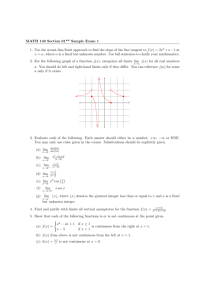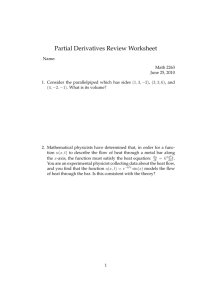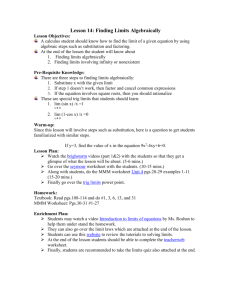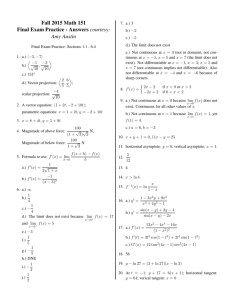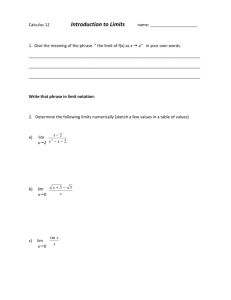Continuity and Limits Worksheet - Math 124
advertisement
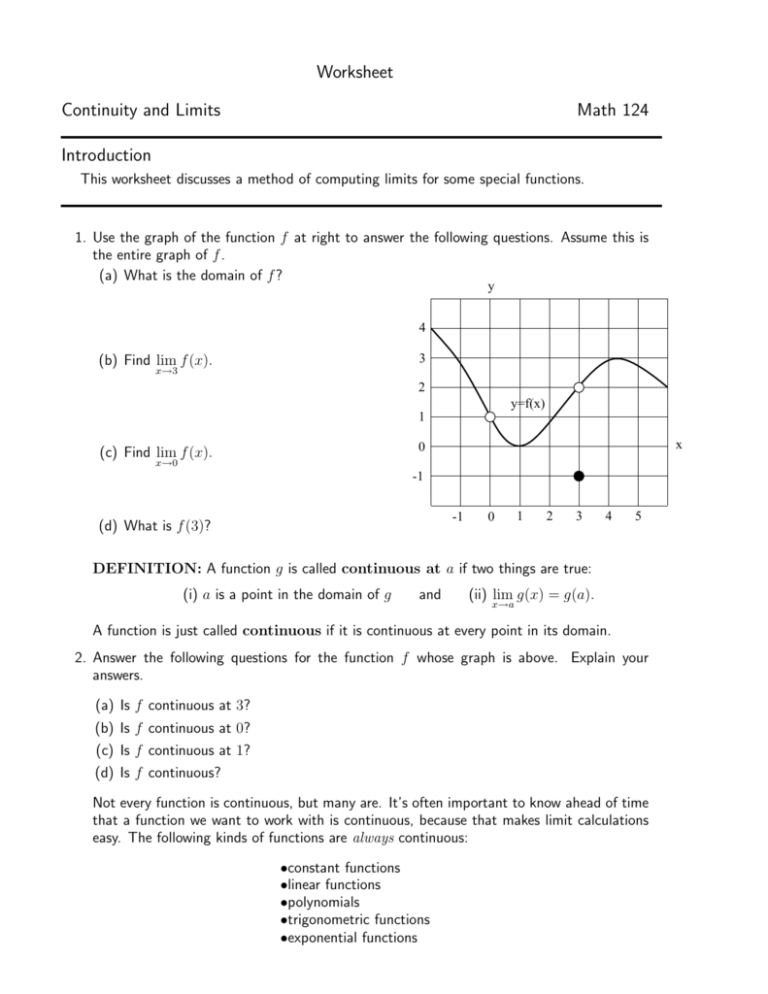
Worksheet Continuity and Limits Math 124 Introduction This worksheet discusses a method of computing limits for some special functions. 1. Use the graph of the function f at right to answer the following questions. Assume this is the entire graph of f . (a) What is the domain of f ? y 4 3 (b) Find lim f (x). x→3 2 y=f(x) 1 x 0 (c) Find lim f (x). x→0 -1 -1 (d) What is f (3)? 0 1 2 3 4 5 DEFINITION: A function g is called continuous at a if two things are true: (i) a is a point in the domain of g and (ii) lim g(x) = g(a). x→a A function is just called continuous if it is continuous at every point in its domain. 2. Answer the following questions for the function f whose graph is above. Explain your answers. (a) Is f continuous at 3? (b) Is f continuous at 0? (c) Is f continuous at 1? (d) Is f continuous? Not every function is continuous, but many are. It’s often important to know ahead of time that a function we want to work with is continuous, because that makes limit calculations easy. The following kinds of functions are always continuous: •constant functions •linear functions •polynomials •trigonometric functions •exponential functions There are many other kinds of continuous functions; some will be explored later in the course. You can also combine continuous functions to make new continuous functions. For example, you can add, multiply or compose continuous functions and be guaranteed to get a continuous function. Division, on the other hand, sometimes creates complications, as we’ll see below. 3. Find lim 3x2 − 2x + 4. Explain your solution. x→2 x2 − 1 by plugging in x = 1? Explain. x→1 x − 1 4. Can you find lim Sometimes we can find a limit of a function where it isn’t continuous or defined by first simplifying the function, so that it resembles a continuous function. 5. Simplify the function in problem number 4, and find the limit of the resulting expression as x → 1. Why can you say that this is the same as the limit you were asked to find in problem number 4? 6. Let e(x) = 125x2 − 6.25x3 . (a) Simplify the expression e(5+h)−e(5) as much as possible; there should not be an h in the (5+h)−(5) denominator of any fraction in the simplified expression. (b) Is e(5+h)−e(5) (5+h)−(5) continuous at h = 0? Why? Is the simplified expression in part (a) continuous at h = 0? Why? e(5 + h) − e(5) using the approach outlined in problem 5. h→0 (5 + h) − (5) (c) Calculate lim 7. Let e(x) = 125x2 − 6.25x3 , as in problem 6. Let x be an unknown constant. (a) Simplify the expression e(x+h)−e(x) as much as possible; there should not be an h in the (x+h)−(x) denominator of any fraction in the simplified expression. (b) Is e(x+h)−e(x) (x+h)−(x) continuous at h = 0? Why? Is the simplified expression in part (a) continuous at h = 0? Why? e(x + h) − e(x) using the approach outlined in problem 5. h→0 (x + h) − (x) (c) Calculate lim





